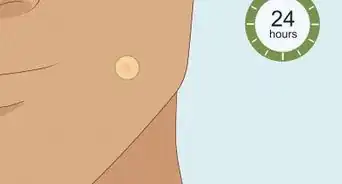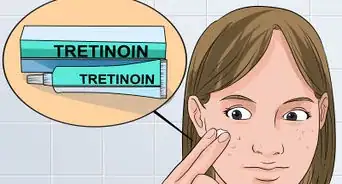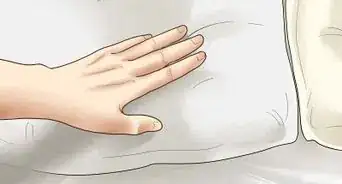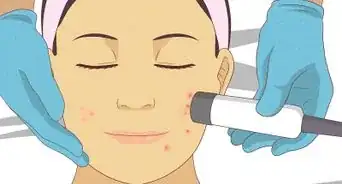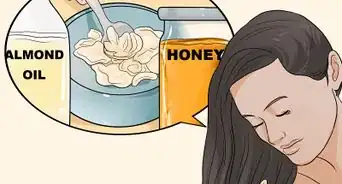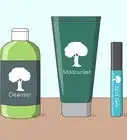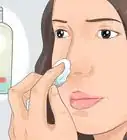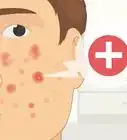This article was medically reviewed by Sarah Gehrke, RN, MS. Sarah Gehrke is a Registered Nurse and Licensed Massage Therapist in Texas. Sarah has over 10 years of experience teaching and practicing phlebotomy and intravenous (IV) therapy using physical, psychological, and emotional support. She received her Massage Therapist License from the Amarillo Massage Therapy Institute in 2008 and a M.S. in Nursing from the University of Phoenix in 2013.
There are 20 references cited in this article, which can be found at the bottom of the page.
This article has been viewed 219,010 times.
Having oily skin can be really annoying. Sometimes you may feel like there’s nothing you can do. Oily skin is caused when your sebaceous glands produce too much sebum. Though this is caused by genetics, hormones, and other factors, there are some things you can do to help control your oily skin. To reduce sebum production, talk to a dermatologist about medication to control it, develop a good cleansing routine, and try some natural remedies.
Steps
Reducing Sebum Production Medically
-
1Get a prescription for retinoids. If you are struggling with excess oil and acne, you may want to talk to a dermatologist about retinoids. This type of medication is one of the most prescribed treatments for acne and excess oil production.[1] You can get an oral retinoid, like Accutane, or topical medications, like tretinoin, adapalene (which is now available over the counter), tazarotene, and isotretinoin. Oral retinoids are generally more effective than topical ones.[2] However, your doctor will most likely prescribe a topical retinoid before trying an oral one to minimize your side effects.[3]
- You may experience side effects like dry skin or sensitive skin, and some drugs, such as Accutane, may have serious side effects.[4]
-
2Talk to your doctor about androgen inhibitors. Excess oil production can be caused by an excess of androgen hormones. If this is why your skin is oily, the doctor may prescribe you an androgen inhibitor, such as spironolactone and cyproterone. These medications can help reduce the amount of sebum your body produces. These medications may be either oral or topical.[5]Advertisement
-
3Ask your doctor about estrogen containing contraceptives.[6] If you are a woman who has excess sebum production, you can try taking a birth control pill. For some women, this can help reduce the oiliness of their skin, but for others it might make it worse. Talk to your doctor about this option to determine if it is right for you.[7]
- Birth control may help reduce the androgens in your body, which can help reduce your body’s sebum production.
-
4Undergo light and laser therapy. Another procedure you may want to try to help your sebum production is light and laser therapy. Photodynamic Therapy and Diode Laser Therapy can work to decrease oil production from your sebaceous glands. Many people use light or laser therapy with other treatments to really reduce their sebum production. However, keep in mind that some medications can make you sensitive to light, so you may not be a candidate for light and laser therapy if you take one of these medications.
- This is a good option for people who cannot use medication to treat their oily skin, such as pregnant women. These treatments are non-invasive and fairly safe.
- You need to get multiple treatments to get the best results. These treatments can be expensive.
Cleaning Your Skin Properly
-
1Wash with a gentle cleanser. One way to help reduce the oil on your skin is to cleanse it properly. Use a gentle noncomedogenic face wash or body wash.[8] Using harsh soaps may cause your skin to produce more oil. Try a basic oil free cleanser, or one with salicylic acid, benzoyl peroxide, beta-hydroxy acid, or glycolic acid. The cleansing ingredients help to dissolve the oils and clean your skin.[9] The other ingredients help to clear away dead skin cells and reduce the amount of acne causing bacteria.
- Try a small amount of the face wash on your skin before using it regularly. These ingredients may irritate your skin, so find one that works for you.
-
2Rinse with warm water. When washing your face, make sure to use warm water instead of hot water. Hot water can irritate your skin. This can cause your skin to produce even more oil. When washing your face or body, use lukewarm water.[10]
-
3Avoid using harsh materials to wash. Though you may think that scrubbing your skin will help get rid of oil that can actually be worse for your skin. Don’t use rough wash rags or bath puffs on your skin. Scrubbing your skin with harsh materials can make your skin create more oil. Either avoid using anything on your skin or use a soft cloth.[11]
-
4Adjust your facial cleaning routine. Your sebum production may vary depending on the season. Your hormone levels may change weekly or monthly and affect your oil production. When you notice that your face and body are oilier than usual, you may want to wash with a cleanser with oil-fighting ingredients more often than when your skin is not as oil.[12]
- You may want to include toners or clay masks to your regimen when you have more oil. Only apply the toner or mask to the oily areas on your face or body. These products can over-dry your skin.
- For example, your body may produce more sebum during the summer than during the winter. This means you may need a different cleanser or cleansing routine during the summer than the winter.
Using Home Remedies to Reduce Sebum
-
1Make an egg white mask. You can have a spa day and make your own mask to help reduce oil production. Egg whites are a natural remedy that can soak the oil on your skin. Make the mask by mixing an egg white with a teaspoon of honey. Add a little bit of flour so you can make a paste for the mask. Place the mask on your face, or any body part that has excess oil.[13]
- After 10 minutes, wash it off with warm water.
-
2Make a baking soda mask. A baking soda mask may also be helpful for reducing sebum. You can make a baking soda mask by mixing three parts baking soda with one part water. Then, apply the paste to your face and massage it into your skin for about five minutes. Rinse thoroughly and dry your face.
-
3Rub on a green tea lotion. Green tea is not just tasty to drink, but it can help reduce sebum production. It has anti-inflammatory and anti-carcinogenic properties.[14] Using a green tea lotion on your face and body may help reduce oil, inflammation, and acne on your skin.[15]
- You can also try drinking more green tea.
-
4Change your diet. Eating healthy can help reduce sebum production naturally. Many vitamins and minerals can help reduce your oil production, but they need to be obtained from food sources to be helpful. You can get the nutrients you need by eating fresh vegetables and fruits and significantly reducing how much processed food you eat.[16]
- Wheat, dairy, and sugar may lead to excess sebum production. Try cutting these things out of your diet to see if they help reduce the amount of oil your body produces.[17]
- Omega-3 fatty acids, found in fish, and monounsaturated fats, found in nuts, help support skin health.[18]
- An unhealthy gut can lead to excess oil production. Probiotics help promote gut health. Try including Greek yogurt, kefir, and sauerkraut into your diet.[19]
-
5Moisturize with argan oil. Argan oil can help with your skin’s sebum production if you have oily skin.[20] Using argan oil on your skin can provide moisture that your skin needs, which can help balance your skin’s natural oil production. You can use argan oil directly on the skin or use products that contain it.[21]
-
6Talk to your doctor about taking vitamin A supplements. Vitamin A supplements can help with acne. However, there are some risks associated with taking high doses of vitamin A, so it is important to talk to your doctor before taking these supplements. You may need to have your liver enzymes monitored while taking vitamin A supplements to ensure that you do not get liver damage.[22]
References
- ↑ https://www.ncbi.nlm.nih.gov/pmc/articles/PMC3088940/
- ↑ http://thescienceofacne.com/sebum/
- ↑ http://www.aafp.org/afp/2004/0501/p2123.html
- ↑ https://www.fda.gov/Drugs/DrugSafety/PostmarketDrugSafetyInformationforPatientsandProviders/ucm094305.htm
- ↑ http://www.dermnetnz.org/topics/sebum/
- ↑ https://www.ncbi.nlm.nih.gov/pmc/articles/PMC3088940/
- ↑ http://www.webmd.com/skin-problems-and-treatments/acne/birth-control-for-acne-treatment#1
- ↑ https://www.aad.org/media/news-releases/--small-changes-in-skin-care-routine-can-significantly-improve-skin-affected-by-acne-and-rosacea
- ↑ http://www.webmd.com/skin-problems-and-treatments/acne/features/oily-skin#1
- ↑ http://www.webmd.com/skin-problems-and-treatments/acne/features/oily-skin#1
- ↑ http://www.besthealthmag.ca/best-you/home-remedies/natural-home-remedies-oily-skin/
- ↑ http://www.webmd.com/skin-problems-and-treatments/acne/features/oily-skin#3
- ↑ http://www.besthealthmag.ca/best-you/home-remedies/natural-home-remedies-oily-skin/
- ↑ https://www.ncbi.nlm.nih.gov/pubmed/10926734
- ↑ https://www.ncbi.nlm.nih.gov/pubmed/20846135
- ↑ http://www.precisionnutrition.com/all-about-acne-nutrition
- ↑ https://www.ncbi.nlm.nih.gov/pubmed/27279815
- ↑ https://www.ncbi.nlm.nih.gov/pmc/articles/PMC3583891/
- ↑ https://chriskresser.com/the-gut-skin-connection-how-altered-gut-function-affects-the-skin/
- ↑ https://www.ncbi.nlm.nih.gov/pubmed/17524128
- ↑ http://www.thedermreview.com/argan-oil/
- ↑ https://livertox.nih.gov/VitaminARetinoids.htm
About This Article
If you want to reduce sebum production, consider talking to your dermatologist about a prescription for topical or oral retinoids. These medications are very effective for treating acne and excess oil production. To manage oily skin at home, be sure to use a gentle noncomedogenic face wash or body wash. You can try a basic oil-free cleanser, or go with a product containing ingredients like salicylic acid, benzoyl peroxide, beta-hydroxy acid, or glycolic acid. These ingredients can help to dissolve oils, clear away dead skin cells, and reduce acne-causing bacteria. For more tips on adjusting your skin care routine, read on!
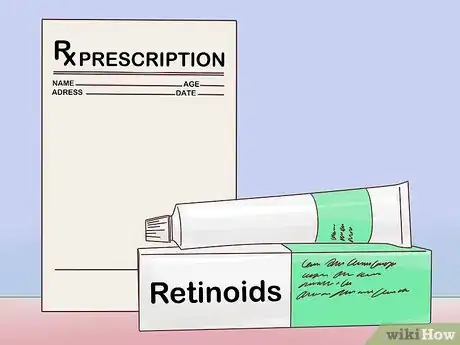




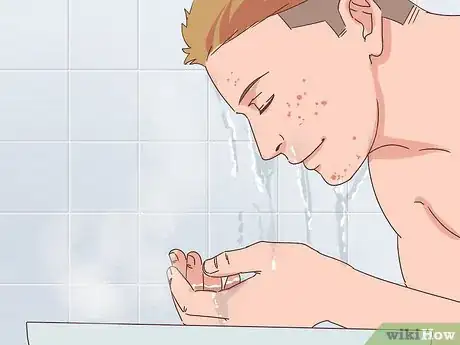




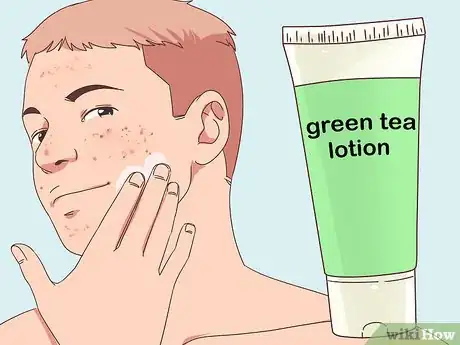

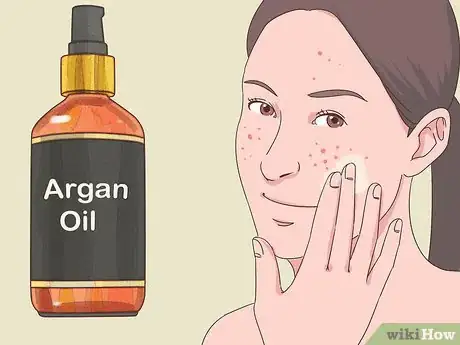


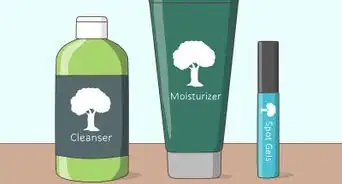
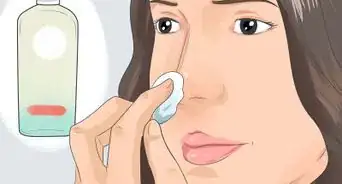

-Step-8-Version-2.webp)


